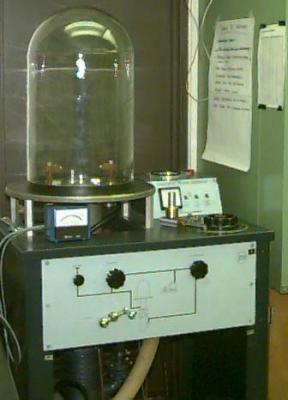Fabrication of Thin Films for Targets
Fabrication of Thin Films for Targets
Robert Johnson, Carmen DiCiantis
Faculty Advisor - Kurt Fletcher
The Geneseo Thin Films lab is relatively new. The lab has two stations. One is an evaporative deposition station and the other uses a plasma deposition method. One of lab's main uses is in fabricating deuerated targets used in the calibration of neutron detectors using the D(d,n) reaction.

Bob Johnson
Plasma Station
To test the thicknesses of some aluminum targets and to calibrate a Rate Deposition Monitor (RDM), an accelerator based method has been used. Robert Johnson will be presenting this work at the 1996 March APS meeting in St Louis:
Production of thin film targets with known properties is often the key to a successful accelerator-based experiment. The goal of this project is to calibrate a device which determines the thickness of such a film during deposition. Aluminum films were evaporated onto glass slides pre-coated with salt in a high vacuum environment. The thickness of the evaporated aluminum was observed during evaporation using an Inficon Rate Deposition Monitor, or RDM. The aluminum film was floated off the glass slide to make a free-standing target, which was tested using the Geneseo 2 MeV Van de Graff accelerator, with 1.05 MeV protons. Rutherford back-scattering was used to determine the measured thickness of the target. For each film, the predicted thickness, determined by the RDM, and the measured thickness, found by the accelerator-based method, were compared. The measured thicknesses tended to be lower than the predicted thicknesses. These data have been used to calibrate the RDM, which will improve ability to produce high quality thin films.